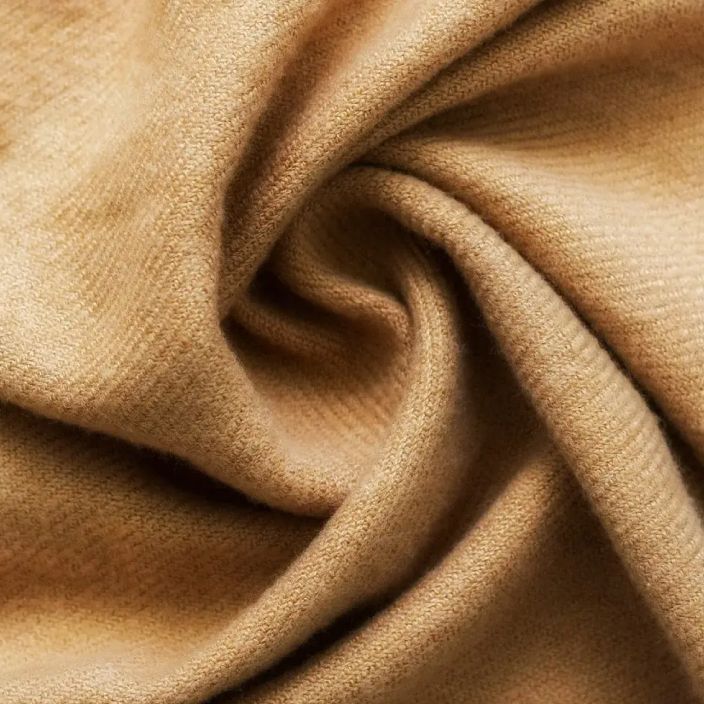For best prices and early deliveries, WhatsApp us at. 918488070070

Cashmere
Cashmere is a premium textile revered for its unparalleled softness, warmth, and lightweight texture, sourced from the fine undercoat of cashmere goats, primarily in regions like Mongolia and Kashmir. Pure cashmere fabric offers a silky, luxurious feel and exceptional insulation, making it ideal for shawls, sweaters, and scarves. Blends with silk or synthetic fibres, such as nylon, enhance durability and affordability, broadening its appeal. Its breathable, moisture-wicking properties make cashmere textile suitable for cool climates, providing elegance and comfort in winter garments like coats and kurtas. Cashmere material’s excellent dye-absorbing capacity supports a range of colours, from muted neutrals to rich tones, accommodating solid hues, subtle patterns, or embroidered designs for traditional and modern styles. Pure cashmere fabric is biodegradable and sustainable when ethically sourced, though its production is labour-intensive, requiring careful combing of goat fleece, which increases costs. Synthetic blends are more economical but less eco-friendly due to their non-biodegradable nature. Cashmere textile is also used in home decor to enhance interiors with throws, cushions, and blankets, adding a cosy, opulent aesthetic. Combining traditional herding practices with modern weaving techniques, cashmere fabric maintains its status as a timeless fabric, offering warmth, elegance, and versatility for diverse fashion and furnishing applications across cultural and seasonal contexts.
The Making of Cashmere
The production of cashmere fabric is a meticulous process that transforms the fine undercoat of cashmere goats into a soft, warm textile. Whether crafted as pure cashmere fabric or blended with silk or synthetic fibres, it involves harvesting, sorting, spinning, weaving, and finishing to create cashmere material for apparel and décor.
The process begins with fibre collection, where cashmere goats, primarily in Mongolia or Kashmir, are combed by hand during spring moulting to gather their soft undercoat, yielding fibres of 12–19 microns. These fibres are sorted to remove coarser guard hairs, ensuring the softness of pure cashmere fabric. For blended cashmere textile, silk or nylon is added for strength and cost-efficiency. The fibres are carded to align them and spun into fine, lightweight yarns using traditional or modern spinning techniques, preserving their delicate texture. Weaving or creating knitted fabric on specialised looms produces cashmere’s smooth, insulating structure, ideal for sweaters or shawls.
Precision is crucial to avoid damaging the fine fibres of pure cashmere. Post-weaving, the fabric is washed to remove impurities, enhancing softness, particularly for pure cashmere material. Dyeing introduces vibrant or neutral hues, supporting woven patterns or embroidery, while finishing processes like milling enhance the fabric’s plush feel. Pure cashmere is sustainable but resource-intensive, relying on ethical herding and slow, manual processes, raising costs. Quality checks ensure flawless texture and warmth, resulting in a luxurious textile that blends traditional craftsmanship with modern efficiency, suitable for elegant garments and cosy home decor.
Utility
Cashmere fabric’s exceptional softness and warmth make it a cornerstone of luxury fashion and home decor. Pure cashmere fabric and blended cashmere textile excel in cool climates, crafting elegant, cosy garments and furnishings across various types of cashmere material.
Pure cashmere fabric, with its silky texture, is ideal for evening wraps, bridal stoles, and festive kurtas, offering warmth and sophistication for winter occasions. Cashmere is also used to craft shawls, sweaters, and dresses. Lightweight scarves and cardigans in cashmere textile provide stylish, breathable layering, while embroidered or patterned cashmere enhances modern co-ord sets or traditional attire, blending heritage with contemporary flair.
Cashmere material is used in menswear, such as sweaters, scarves, and coats. Pure cashmere fabric offers a luxurious feel for formal kurtas or evening shawls, while blended cashmere textile ensures durability for jackets, providing comfort for work or events. Its moisture-wicking nature supports extended wear, with subtle weaves adding elegance.
In home decor, cashmere fabric’s plush texture enhances interiors with luxurious throws, cushions, and blankets, creating a warm, inviting ambience in living rooms or bedrooms. Cashmere textile in decorative accents introduces refined patterns, complementing modern or traditional settings. The fabric’s dye-friendly nature supports diverse designs, from minimalist solids to intricate motifs.
From luxury fashion to inviting home decor, cashmere fabric offers a timeless appeal, seamlessly blending age-old herding traditions with contemporary functionality to suit diverse styles, seasons, and settings.
Image Credits
Davonne Textiles